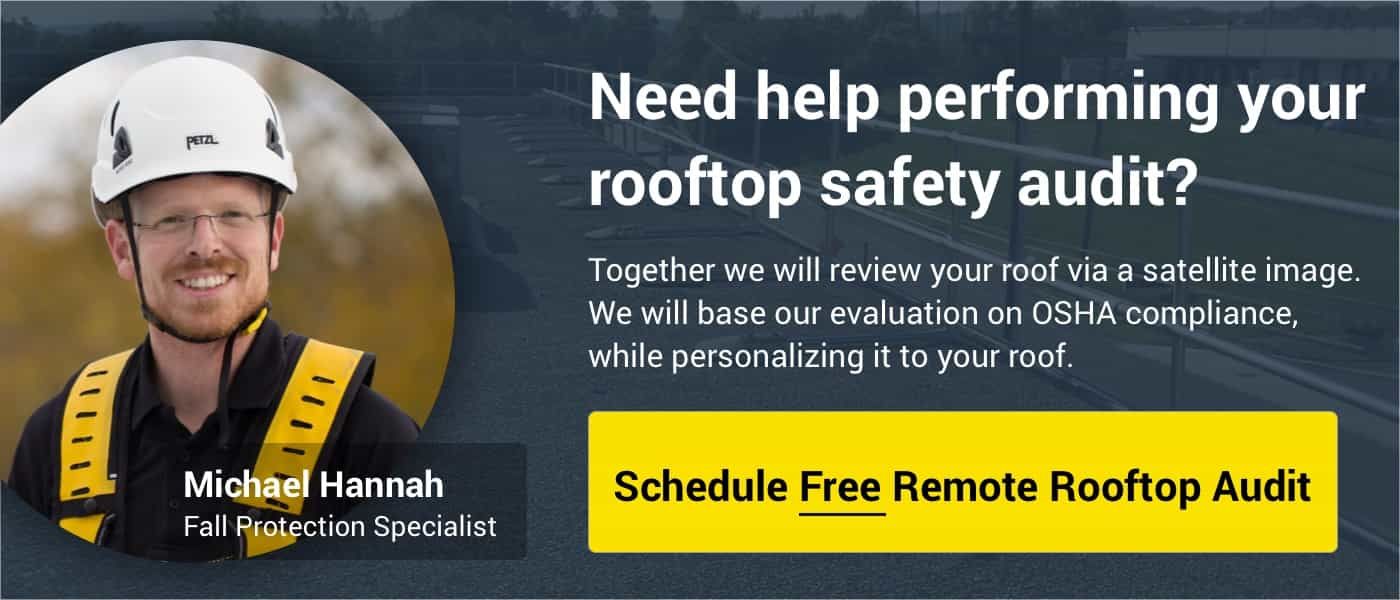Overview of Fall Protection Options
When employees are exposed to heights over 6 feet above lower levels, they shall be protected from falling by guardrail systems, safety net systems, or personal fall arrest systems. The following Heroic Safety Huddle defines the details and specific regulations pertaining to these protection systems as set forth by OSHA CFR Part 1926.502.
Guardrail Systems shall comply with the following provisions:
-
Top edge height of top rails shall be 42 inches plus or minus 3 inches above walking/working level
-
Midrails shall be installed between top rail and working surface where there is no wall or parapet at least 21 inches high
-
Screens and mesh used shall extend the entire opening from top rail to working surface
-
Intermediate members (balusters) shall be no more than 19 inches apart
-
Guardrails must be capable of withstanding 200 lbs. applied within 2 inches of the top edge in any outward or downward direction
-
When 200 lbs. is applied in downward direction, the top edge of guardrail shall not deflect below 39 inches from working surface
-
Midrails, screens, and mesh shall be capable of withstanding 150 lbs. in outward or downward direction
-
Guardrails to be surfaced to prevent injury to employees from punctures and lacerations
-
The ends of all top rails and midrails shall not extend past terminal posts
-
Steel banding or plastic banding shall not be used as top rails or midrails
-
Top rails and midrails shall be at least 1/4 inch nominal diameter or thickness
-
Wire rope top rails shall be flagged at no more than 6 ft. intervals by highly visible material
-
Guardrail systems used around holes that are used for access points shall have a gate
-
Guardrail systems used on ramps and runways shall be erected on all unprotected sides
Safety Net Systems shall comply with the following provisions:
-
Shall be installed as close as practicable under the walking/working surface on which employees are working
-
Shall extend outward from the outermost projection of the work surface as follows:
-
5 ft. to net (vert.) = 8 ft. from net edge to working edge (horz.)
-
5 to 10 ft. = 10ft.
-
more than 10 ft. = 13 ft.
-
Shall be installed with sufficient clearance under net to prevent contact with surface or objects below
-
Drop test to be performed at installation, before being used as fall protection, after relocation, after major repairs, and at 6 month intervals
-
Drop test consists of dropping 400 lb. bag of sand 30 inches in diameter into net from highest working surface
-
Inspected at least once per week
-
Defective nets not to be used
Personal Fall Arrest Systems shall comply with the following:
-
As of January 1, 1998, body belts are not acceptable as part of a personal fall arrest system
-
Only positioning systems
-
Connectors shall be drop forged, pressed, or formed steel
-
Surfaces and edges shall be smooth
-
Dee-rings and snaphooks shall have minimum tensile strength of 5,000 lbs.
-
Unless a locking-type snaphook, they shall not be engaged:
-
directly to webbing, rope or wire rope
-
to each other
-
to a Dee-ring to which another snaphook or other connector is attached
-
to a horizontal lifeline
-
Horizontal lifelines shall be designed, installed, and used in a manner which maintains a safety factor of at least two
-
Lanyards and vertical lifelines shall have a minimum breaking strength of at least 5,000 lbs.
-
Except during the construction of elevator shafts, each employee shall be attached to a separate lifeline
-
Lifelines to be protected from cuts and abrasions
-
Ropes and webbing straps used in lanyards, lifelines, body belts and harnesses shall be composed of synthetic fibers
-
Anchorages used for attachment shall be capable of supporting at least 5,000 lbs. per employee attached
-
Personal fall arrest systems, when stopping a fall, shall:
-
Limit maximum arresting force to 1800 lbs when used with a body harness
-
Be rigged such that an employee can neither free fall more than 6 ft. nor contact any lower level
-
Bring an employee to a complete stop and limit max deceleration distance an employee travels to 3.5 ft.
-
Have sufficient strength to withstand twice the potential impact energy of an employee free falling a distance of 6 ft.
-
Employee shall provide for prompt rescue of employees in the event of a fall or shall assure that employees are able to rescue themselves
-
Personal fall arrest systems shall be inspected prior to use, post damage or other deterioration, and defective components shall be removed from service
-
Shall not be attached to guardrail systems
Editorial Note: links were added to Dan's post to provide a connection to the products that represent the topics he was referring to.



